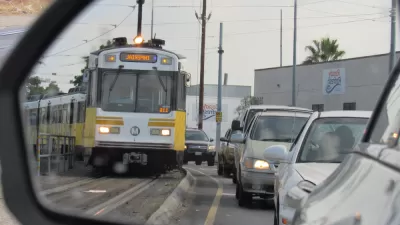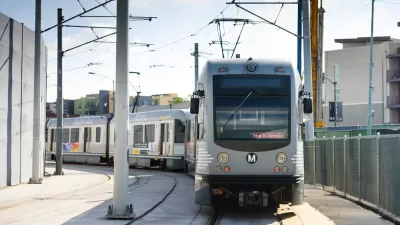Over a century ago, the Pacific Electric Railway operated a line between downtown Los Angeles and Long Beach that competed its journey ten minutes faster than LA Metro's Blue Line does. What gives?

Back in 1916, Brian Addison writes, "the Pacific Electric Railway's Long Beach line, which stretched directly from Downtown Los Angeles to Downtown Long Beach, was nearly ten minutes faster than the current line."
Slow rail transit is arguably better than no rail transit, a deprivation Los Angeles suffered for several decades after the demise of its early 20th century rail transit system. But as Addison points out, "the Long Beach stretch of [the Blue Line] is the only stretch that doesn't have a signal preemption or synchronization system—that is, controllers for the movement of traffic that gives preference to Metro trains rather than street traffic."
That means trains slow to a snail's crawl as they navigate traffic signals, getting bogged down with automobile traffic.
Thankfully, the Los Angeles County Metropolitan Transportation Authority is on the case: the line is currently undergoing rehabilitation to address the issue and will fully reopen on November 2. "Workers have been fine-tuning the systems attached to create priority for the train to save time for commuters," Addison writes. Still, time savings will likely not exceed the ten-minute mark.
FULL STORY: Opinion: C’mon, Metro—the LA-to-LB rail line was quicker a century ago than it is now

Montreal Mall to Become 6,000 Housing Units
Place Versailles will be transformed into a mixed-use complex over the next 25 years.

Planetizen Federal Action Tracker
A weekly monitor of how Trump’s orders and actions are impacting planners and planning in America.

DARTSpace Platform Streamlines Dallas TOD Application Process
The Dallas transit agency hopes a shorter permitting timeline will boost transit-oriented development around rail stations.

Without International Immigrants, the Rural US Population Would Be Falling 58%
Census data shows that population growth in rural areas is due in large part to international migrants.

Dead End: Nine Highways Ready for Retirement
The Freeways Without Futures report describes the nation’s most promising highway removal proposals.

Congressman Proposes Bill to Rename DC Metro “Trump Train”
The Make Autorail Great Again Act would withhold federal funding to the system until the Washington Metropolitan Area Transit Authority (WMATA), rebrands as the Washington Metropolitan Authority for Greater Access (WMAGA).
Urban Design for Planners 1: Software Tools
This six-course series explores essential urban design concepts using open source software and equips planners with the tools they need to participate fully in the urban design process.
Planning for Universal Design
Learn the tools for implementing Universal Design in planning regulations.
City of Mt Shasta
City of Camden Redevelopment Agency
City of Astoria
Transportation Research & Education Center (TREC) at Portland State University
City of Camden Redevelopment Agency
Municipality of Princeton (NJ)
Regional Transportation Commission of Southern Nevada





























